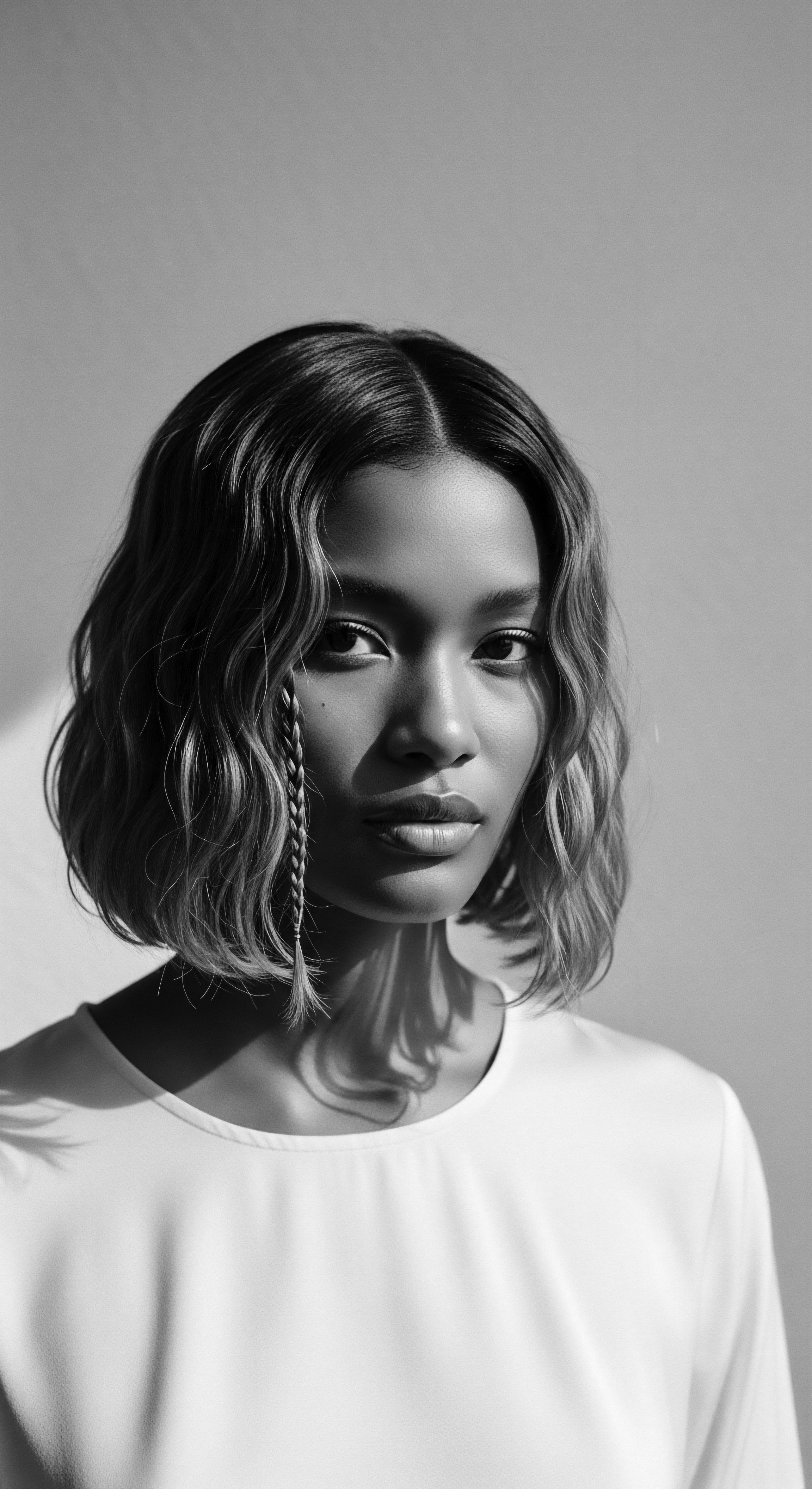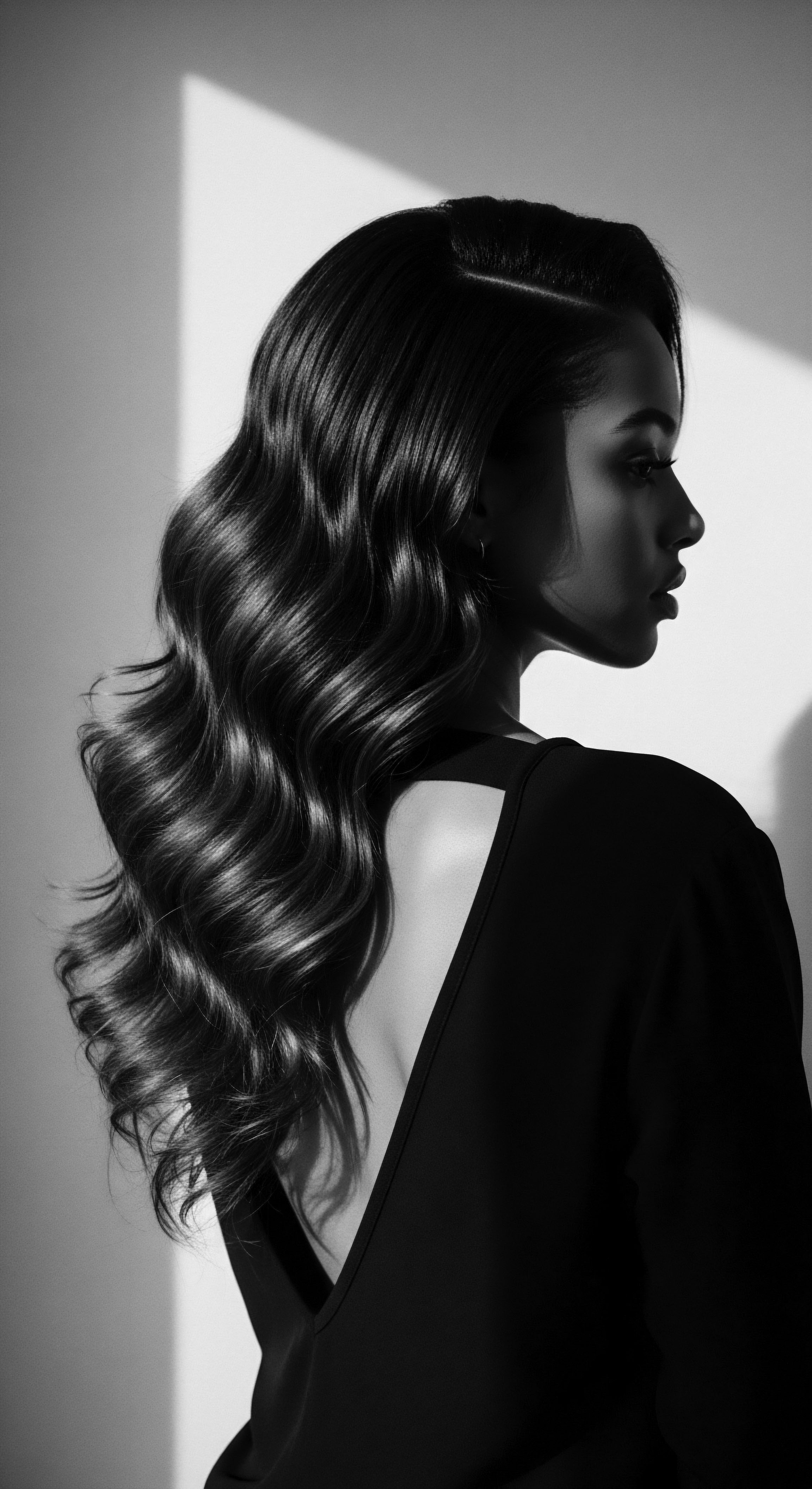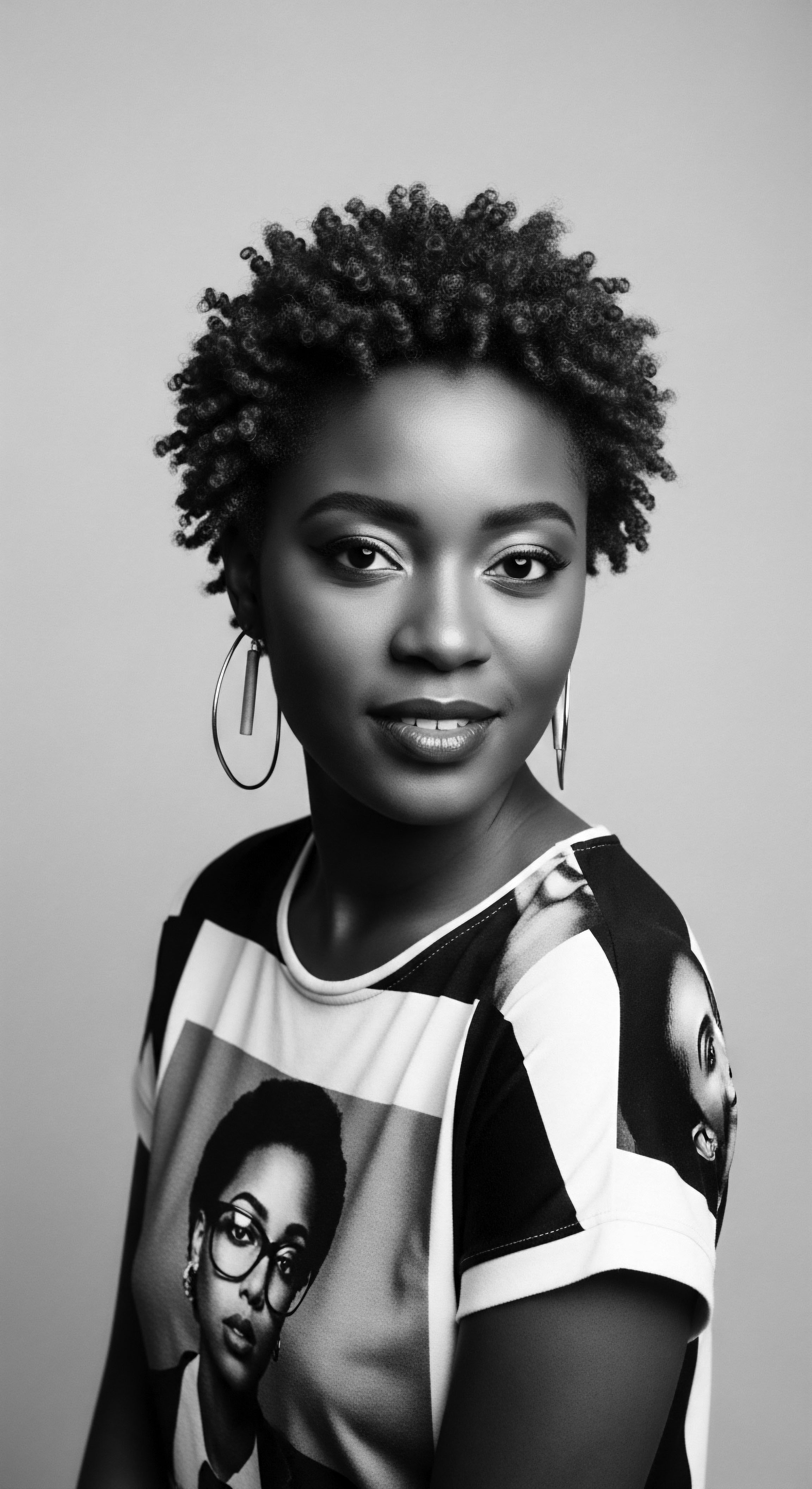
Fundamentals
The exploration of Textured Hair Tools begins not with a simple designation, but with a reverence for their enduring place within the continuum of human expression and care. At its very heart, the Definition of Textured Hair Tools encompasses any implement, natural or crafted, that aids in the cleansing, conditioning, detangling, styling, or adornment of hair exhibiting a discernible curl, coil, or wave pattern. This includes a vast spectrum, from the elemental touch of human hands, often the first and most intimate tool, to the intricate combs and picks fashioned from natural materials, and extending to the contemporary innovations that honor the unique architectural marvel of textured strands. The Meaning of these tools transcends mere functionality; they are extensions of cultural identity, historical memory, and the tender rituals passed down through generations.
For those new to the profound world of textured hair, understanding these tools requires an appreciation for the hair’s inherent characteristics. Textured hair, in its myriad forms across Black and mixed-race ancestries, possesses a distinct helical structure, prone to dryness and tangling due to its natural bends and curves. Thus, the tools designed for its care are specifically conceived to navigate these intricate pathways with gentleness and precision.
The earliest implements were often intuitive, shaped by the environment and the wisdom gleaned from observing nature’s own patterns. These rudimentary tools, though simple in form, carried immense cultural weight, signifying community bonds, rites of passage, and individual expression.
Textured Hair Tools are more than just implements; they are vessels of ancestral wisdom, facilitating the intimate dance between hand and strand, connecting present care to a storied past.

The Genesis of Care ❉ Early Implements
Long before the advent of modern materials, the hands of caregivers served as the primary instruments for tending textured hair. Fingers, nimble and sensitive, could detangle, part, and braid with an intimacy unmatched by any manufactured item. Alongside this primal connection, early communities across Africa and the diaspora began to fashion tools from readily available natural resources. These early implements were often imbued with a spiritual or symbolic Significance, reflecting the deep reverence for hair as a conduit for spiritual energy and a marker of identity.
- Fingers ❉ The most ancient and versatile tool, offering unparalleled tactile feedback for gentle detangling and precise sectioning.
- Wooden Combs ❉ Carved from resilient woods, these wide-toothed combs were designed to glide through dense coils without causing undue stress.
- Bone and Ivory Picks ❉ Often elaborately decorated, these served not only for styling but also as indicators of social standing or ceremonial significance.
The creation of these tools was often a communal affair, a shared knowledge passed from elder to youth, reflecting the collective understanding of textured hair’s unique needs. This ancestral ingenuity laid the foundation for the complex array of tools we recognize today, each bearing an echo of its earliest forms and the wisdom of its initial creators. The Explanation of these foundational tools provides a lens through which to view the continuous journey of textured hair care, a journey deeply rooted in heritage and a testament to enduring creativity.

Intermediate
Moving beyond the foundational understanding, the Meaning of Textured Hair Tools deepens to encompass their evolving role within the socio-cultural landscape of Black and mixed-race communities. These implements are not static artifacts but dynamic participants in a living history, adapting to shifting aesthetics, societal pressures, and the continuous quest for self-affirmation. The journey of these tools mirrors the resilience of textured hair itself, navigating periods of suppression and celebration, always finding new ways to express its inherent beauty and cultural gravitas. The Delineation of their intermediate context requires acknowledging their dual function ❉ as practical aids and as powerful symbols.
As diasporic communities spread across continents, the tools of textured hair care traveled with them, adapting to new environments and materials, yet retaining their ancestral spirit. The practice of hair care became a clandestine act of resistance, a quiet defiance against forced assimilation, and the tools used in these intimate rituals became cherished possessions. From the shared moments of braiding on a porch to the communal gatherings where hair was dressed for ceremony, these tools were present, silently bearing witness to stories of survival, creativity, and identity. Their Interpretation is thus inseparable from the narratives of those who wielded them.

The Evolution of Utility and Symbolism
The mid-20th century, particularly within the African American community, saw a significant transformation in the tools available for textured hair. While some innovations sought to alter the natural texture to conform to Eurocentric beauty standards, others emerged as powerful statements of cultural pride. The development of the Hair Pick with a Fist Handle, for instance, became an iconic symbol of the Black Power movement, asserting identity and rejecting imposed norms. This particular tool, while functional for detangling and styling, carried a potent political and social message, transforming a utilitarian item into a powerful emblem of self-acceptance and collective strength.
Beyond their functional application, Textured Hair Tools serve as potent symbols, embodying cultural narratives, resilience, and the ongoing affirmation of identity across generations.
The continued development of tools reflects a growing scientific understanding of textured hair’s unique properties, coupled with a renewed reverence for ancestral care practices. This period saw the blending of traditional knowledge with modern material science, leading to more specialized brushes, combs, and accessories designed to minimize breakage and maximize definition. The Clarification of this phase of development underscores a critical shift ❉ from tools that sought to control or alter texture, to those that sought to honor and enhance its natural form.
Consider the following examples of tools that gained prominence during this period, each serving a distinct purpose while contributing to the broader narrative of textured hair care ❉
- Wide-Tooth Combs ❉ Essential for detangling wet or conditioned hair, their generous spacing prevents snagging and breakage, preserving the integrity of the coil.
- Denman-Style Brushes ❉ Known for their precise row patterns and rubber bases, these brushes aid in curl clump formation and distribution of styling products, enhancing natural texture.
- Satin or Silk Bonnets/Scarves ❉ While not a ‘tool’ in the traditional sense, these protective coverings minimize friction and moisture loss, acting as an indispensable aid in preserving styles and hair health, a modern echo of ancestral head coverings.
The historical context of these tools reveals a dynamic interplay between practicality and cultural expression. The very act of choosing a specific tool, whether a wide-tooth comb or a satin bonnet, becomes a conscious decision to engage with a heritage of care and a legacy of self-determination. This deeper Understanding highlights how Textured Hair Tools are not merely instruments but active participants in the ongoing dialogue between past and present, tradition and innovation.
| Historical Period/Context Ancient African Kingdoms (e.g. Egypt, Nubia) |
| Primary Materials Wood, Bone, Ivory, Metal |
| Dominant Purpose/Cultural Significance Detangling, Styling, Adornment, Status Symbol, Ritual Object |
| Historical Period/Context Transatlantic Enslavement & Post-Emancipation |
| Primary Materials Limited natural materials, eventually metal combs |
| Dominant Purpose/Cultural Significance Basic grooming, often clandestine care, subtle expression of identity |
| Historical Period/Context Early 20th Century (e.g. Madam C.J. Walker era) |
| Primary Materials Metal (hot combs), early plastics |
| Dominant Purpose/Cultural Significance Texture alteration (straightening), social assimilation, economic opportunity |
| Historical Period/Context Mid-Late 20th Century (Natural Hair Movement) |
| Primary Materials Plastic, wood, metal (picks with symbolic handles) |
| Dominant Purpose/Cultural Significance Texture affirmation, detangling, styling, political statement, identity assertion |
| Historical Period/Context 21st Century (Contemporary Natural Hair Movement) |
| Primary Materials Advanced plastics, silicone, wood, bamboo, sustainable materials |
| Dominant Purpose/Cultural Significance Gentle detangling, curl definition, scalp health, protective styling, holistic care |
| Historical Period/Context This progression illustrates a continuous adaptation of materials and a shifting emphasis, from ancestral reverence to periods of external pressure, culminating in a contemporary return to honoring natural texture and its rich heritage. |

Academic
The academic Definition of Textured Hair Tools extends beyond their practical application, delving into their profound anthropological, sociological, and even psychological Significance within the human experience, particularly for individuals of Black and mixed-race heritage. From this vantage point, these tools are conceptualized as cultural artifacts, embodying complex layers of meaning that reflect societal norms, power dynamics, aesthetic values, and the enduring human need for self-expression and connection to ancestry. The Elucidation of this concept necessitates an interdisciplinary lens, drawing from ethnobotany, material culture studies, and the history of Black beauty practices.
To truly comprehend the deep Meaning of Textured Hair Tools, one must recognize them as tangible links to a rich and often contested heritage. They are not merely inert objects; they are active participants in the construction and maintenance of identity, memory, and community across generations. The very act of designing, using, or passing down a hair tool can be viewed as a form of cultural transmission, carrying forward embodied knowledge and ancestral wisdom. This perspective moves beyond a superficial Description, inviting a rigorous analysis of their historical trajectory and contemporary impact.

Ancestral Ingenuity and the Cultural Anthropology of Tools
In many pre-colonial African societies, hair care was a communal, ritualistic activity, and the tools employed were often imbued with spiritual and social weight. These implements, ranging from simple sticks for parting to intricately carved combs and adornments, were extensions of the self and the collective. They facilitated practices that reinforced social hierarchies, marked life stages, and communicated spiritual beliefs. For instance, archaeological findings from ancient Egypt and Nubia reveal a diverse array of combs, often adorned, signifying their role beyond mere utility to that of ceremonial objects or indicators of social standing.
Dr. W. M. F.
Petrie’s archaeological expeditions in ancient Egypt uncovered numerous combs and hair implements, often crafted from wood, bone, or ivory, some dating back to the Predynastic period (Petrie, 1920). These artifacts reveal not only advanced craftsmanship but also the meticulous attention paid to hair care, indicating that these tools were integral to daily life and cultural rituals. The presence of such items in burial sites further underscores their significance, suggesting they held spiritual or symbolic value, accompanying individuals into the afterlife and reinforcing the deep ancestral connection between self, hair, and the tools used to adorn it. This historical continuity underscores how tools for textured hair have always been extensions of identity and cultural expression.
The meticulous Specification of these historical tools reveals their connection to specific cultural narratives. For example, in West African traditions, particular combs were not just for detangling but were used in ceremonial hair preparations for weddings or coming-of-age rites, each stroke a blessing, each part a delineation of identity. The materials chosen for these tools were often locally sourced, reflecting a harmonious relationship with the environment and a deep understanding of natural properties. The use of specific woods or animal bones for their durability and gentle interaction with hair speaks to an empirical knowledge refined over millennia.
Textured Hair Tools, when viewed through an academic lens, reveal themselves as potent cultural artifacts, embodying historical power dynamics, evolving aesthetic values, and the enduring human need for self-expression.

Diasporic Adaptation and the Sociology of Hair Practices
The forced migration of African peoples during the transatlantic slave trade profoundly reshaped the landscape of textured hair care and its associated tools. Stripped of their traditional implements and often denied access to natural resources, enslaved individuals ingeniously adapted, using what was available—fingers, thorns, repurposed household items—to maintain their hair. These acts of care, though often clandestine, became vital expressions of dignity, resistance, and the preservation of cultural memory.
The hair practices and the improvised tools became a means of coded communication, a silent language of survival and resilience. The Designation of these practices as forms of resistance highlights the extraordinary ingenuity born from profound adversity.
Post-emancipation, and particularly in the early 20th century, the emergence of the “hot comb” represented a complex chapter in the history of textured hair tools. While often seen as a tool of assimilation, promoting Eurocentric beauty standards, its widespread adoption also provided a means for Black women to navigate societal pressures and create economic opportunities. Innovators like Madam C.J. Walker revolutionized hair care for Black women, developing products and tools that, while sometimes promoting straightening, also created a pathway for economic independence and a sense of agency within a restrictive social framework.
This period illustrates the intricate ways in which tools can become entangled with broader socio-economic and political forces, reflecting both aspirations and constraints. The Interpretation of this era must acknowledge the multifaceted motivations behind tool adoption.
The latter half of the 20th century and the dawn of the 21st witnessed a powerful resurgence of the natural hair movement, a global phenomenon that fundamentally re-evaluated the Meaning and purpose of Textured Hair Tools. This movement championed the inherent beauty of coils, curls, and waves, rejecting the pressure to conform. Consequently, there was a renewed demand for tools that celebrated and supported natural texture, leading to innovations in wide-tooth combs, detangling brushes designed specifically for curl patterns, and protective accessories. This shift represents a conscious reclamation of ancestral aesthetics and a profound commitment to holistic hair wellness.
The academic Description of Textured Hair Tools today must also consider their psychological impact. The choice of tools, the rituals of hair care, and the resulting styles contribute significantly to self-perception, body image, and a sense of belonging. For many with textured hair, particularly those from marginalized communities, the journey of understanding and caring for their hair is deeply intertwined with personal growth and collective identity formation. The tools become companions in this journey, facilitating a deeper connection to one’s heritage and an affirmation of self.

The Interconnectedness of Care and Identity ❉ A Contemporary Analysis
Contemporary academic discourse often examines Textured Hair Tools through the lens of intersectionality, recognizing that experiences with hair and its care are shaped by race, gender, class, and cultural background. The availability, accessibility, and cultural acceptance of specific tools vary significantly across different communities and socio-economic strata. For example, access to high-quality, gentle detangling tools might be limited in underserved communities, impacting hair health and potentially perpetuating cycles of hair damage. This highlights the ongoing disparities that affect hair care practices and the tools employed.
Furthermore, the globalized market for Textured Hair Tools presents both opportunities and challenges. While it allows for a wider array of specialized products, it also necessitates a critical examination of how traditional knowledge is appropriated or commercialized. Academic inquiry seeks to understand how contemporary tool development can honor ancestral wisdom while meeting modern needs, ensuring that the innovation serves the community rather than exploiting its heritage. This calls for an ethical approach to product development and marketing, prioritizing the health and cultural integrity of textured hair.
The ongoing academic exploration of Textured Hair Tools provides crucial insights into their long-term consequences and success insights. By studying the historical patterns of tool usage, the impact of various materials on hair health, and the socio-cultural narratives surrounding hair care, researchers can contribute to a more holistic understanding of textured hair. This knowledge can inform the development of more effective and culturally sensitive tools, promote healthier hair practices, and reinforce the profound connection between hair, identity, and heritage. The goal is to ensure that future innovations continue to respect and build upon the rich legacy of care passed down through generations, supporting not just hair health, but the overall well-being and cultural affirmation of individuals with textured hair.

Reflection on the Heritage of Textured Hair Tools
As we draw this meditation on Textured Hair Tools to a close, we recognize that their Meaning extends far beyond the physical realm of their construction or immediate utility. These implements, from the simplest finger to the most specialized brush, stand as enduring testaments to the ingenuity, resilience, and profound spirit of those who have tended textured strands throughout history. They are not mere objects, but conduits of ancestral wisdom, each curve and bristle whispering stories of survival, creativity, and the unwavering pursuit of self-expression. The very act of engaging with these tools, whether detangling a child’s coils or styling one’s own crown, becomes a sacred ritual, a living connection to the hands that came before us.
The journey of Textured Hair Tools, as explored within Roothea’s ‘living library,’ illuminates the ‘Soul of a Strand’ ethos with unparalleled clarity. It reveals how the intimate practices of hair care are inextricably linked to identity, community, and the collective memory of a people. From the ancient African kingdoms where combs were symbols of status and spirituality, to the quiet acts of resistance during periods of oppression, and through the vibrant resurgence of natural hair pride, these tools have always been present, adapting, evolving, yet retaining their core Significance as instruments of care and cultural affirmation.
They remind us that our hair is not just a biological attribute, but a profound canvas upon which heritage is painted, generation after generation. The ongoing dialogue between tradition and innovation in textured hair care ensures that this rich legacy continues to flourish, honoring the past while shaping a future where every strand is celebrated in its authentic glory.

References
- Byrd, A. D. & Tharps, L. (2014). Hair Story ❉ Untangling the Roots of Black Hair in America. St. Martin’s Press.
- Mercer, K. (1994). Welcome to the Jungle ❉ New Positions in Black Cultural Studies. Routledge.
- Petrie, W. M. F. (1920). Tools and Weapons ❉ Illustrated by the Egyptian Collection in University College, London. British School of Archaeology in Egypt.
- Patton, T. O. (2006). African American Hair ❉ An Examination of the Social and Cultural Significance of Hair in the African American Community. University Press of Mississippi.
- Banks, I. (2000). Hair Matters ❉ Beauty, Power, and Black Women’s Consciousness. New York University Press.
- Dunlap, L. (2016). Natural Hair Care and Braiding. Milady.
- Okoro, N. (2013). African Hairstyles ❉ Styles of Yesterday and Today. National Museum of African Art.
- Spellers, S. (2020). The Science of Black Hair ❉ A Comprehensive Guide to Textured Hair Care. Independently published.
- Thompson, C. (2009). Black Women, Beauty, and Power. University of Illinois Press.
- White, J. (2019). Textured Hair ❉ A Comprehensive Guide to Care and Styling. Hair Science Publications.
